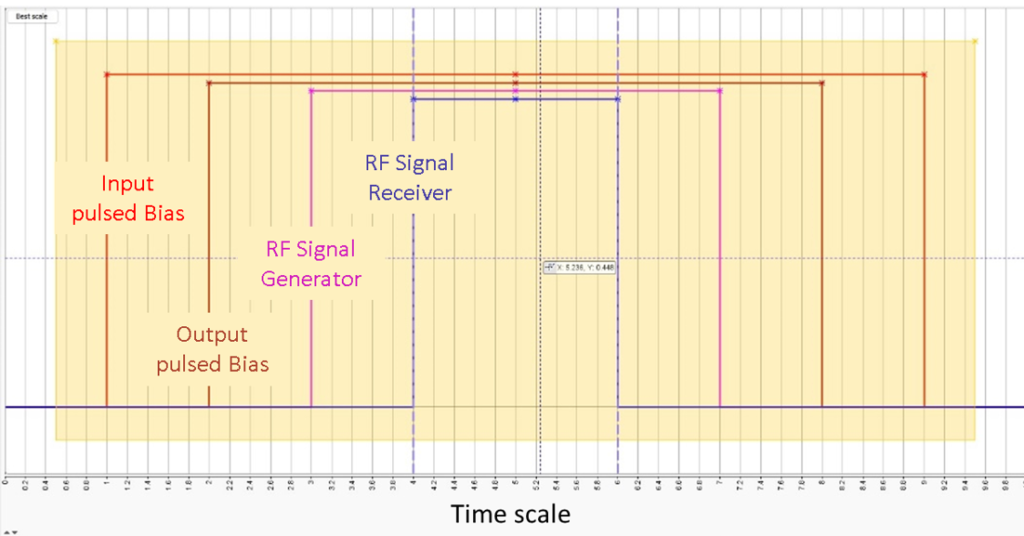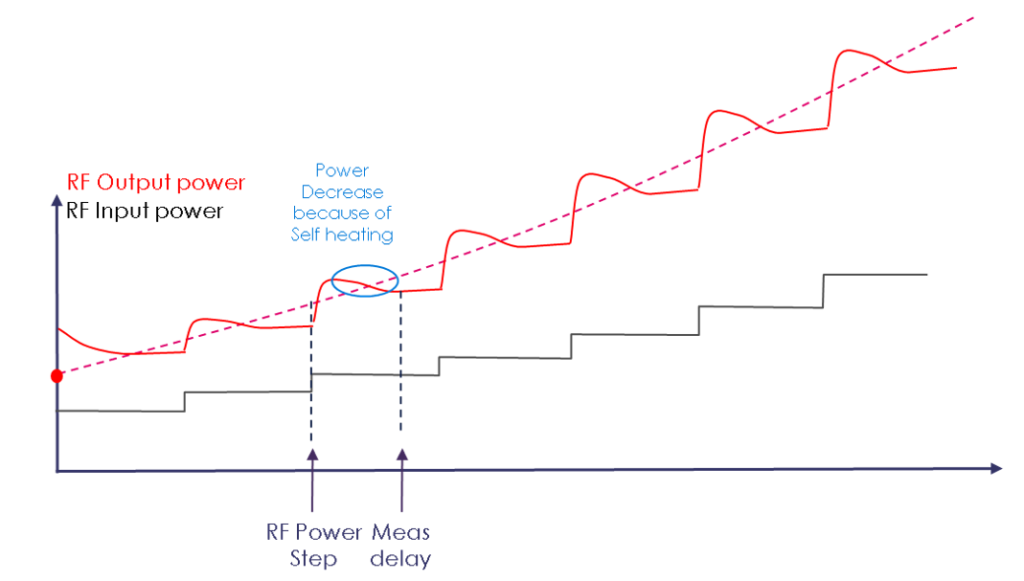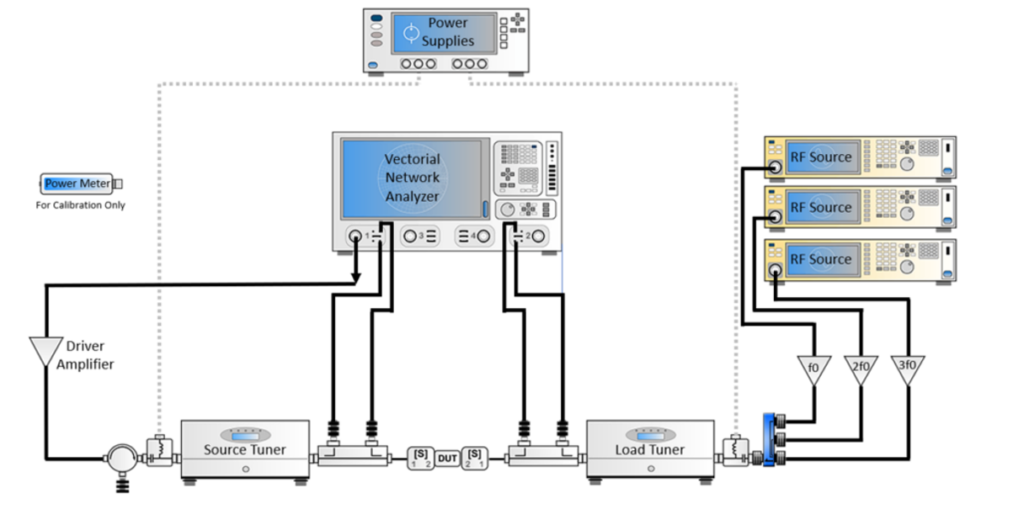AMCAD Engineering and its strategic partner Maury Microwave are pleased to announce that the new IVCAD 3.10 version has been released. We have added new features and upgraded the solution. Here are the good reasons to switch to IVCAD 3.10 :
Load Pull application: Set Delay before RF measurements

Issue : When measuring RF components using a load pull setup, at high-power level, the dissipated power can dramatically change the temperature of the component under test.
Even though this phenomenon can be managed by pulsed RF measurements, a full control of the measurement timing can be necessary. In the previous version of IVCAD, thanks to the chronogram tool, it was possible to control the timing between the moment when the RF signal was applied and the moment when the measurement window was defined.
These settings help to limit the self-heating during load pull tests, but they are only valid for pulsed measurements.
For CW measurements, we may face some situations where the self-heating also needs to be managed to get a correct understanding of the DUT’s performances in steady state conditions.
To the contrary of pulsed measurements, in CW mode, there were not specific delay sequences to make sure that the measurements were well managed, especially for devices where the thermal time constants could be relatively long. For some components, if the power sweep is too fast, the measurement results may not be representative of the real device performances. In such conditions, it may be necessary to slow down the measurement process, to reach a thermal steady state before acquiring the data.

In IVCAD 3.10, the measurement delay can now be specified between the moment when the signal is applied, and the moment when the measurement is performed.
This feature enables to find the thermal time constant which must be considered to evaluate figures of merit such as power gain, power added efficiency, dissipated power, for example.


Load Pull application: Update on default active tuning settings

When performing active load pull measurements, a reliable algorithm is needed to set the phase and power level of the output RF source which is used to set the active load impedance.
It is indeed required to converge toward the desired target, without going through load impedance areas within or outside the Smith chart for which the transistors may be damaged.
While this can be managed efficiently managed at fundamental frequencies, this could become trickier at harmonic impedances.

Indeed, each time the phase or the power level of the reverse signal is changed by the active source, it changes in return the power level of the forward signal delivered by the device under test. As a consequence, the convergence toward the target is achieved when a dynamic balance between the power delivery by the DUT and the power delivered by the active source is reached. At harmonic frequencies, a small change of the load impedance can cause a strong variation of the power level delivered by the DUT. Thus it is necessary to use a reliable active load pull algorithm controlled by relevant settings, such as the authorized power step level between two iterations.
In this menu , the Automatic Step can be managed automatically by the algorithm to optimize the convergence speed. Nevertheless, in case of sensitive measurements, it is possible to reduce manually the maximum value of the power step used by the algorithm. In that case, the convergence may be slower, but the risk of presenting an active impedance out of the Smith chart, or the risk of being stuck in a local minimum area can be avoided.
Wave Guide Load Pull Measurements: Added new setup options: active tuning factors.
The same settings on the active tuning have been added to the wave guide active load pull to facilitate the convergence toward active load impedances at millimeter wave frequencies.
MTune 2.00.31 supported: Nano 5G Tuner supported

Mtune includes now drivers controlling Nano 5G tuners. These tuners can be mounted as close as possible to the measurement reference plane in order to limit losses between the DUT and the tuner. It increases the tuning range and decrease the phase skew when modulated signals are used. For example, Nano5G automated impedance tuner can help reach Gamma > 0.87 at the probe tip at 5G FR2 frequencies between 26-40 GHz, and reduce typical phase skew from >200 degrees to <30 degrees when considering a 100 MHz signal with two adjacent side channels.
New Measurement Features
In terms of device security, IVCAD 3.10.2 enables the possibility to set STOP CONDITIONS on the current measurements from auxiliaries’ power supplies. This new feature give more flexibility to choose the right trigger to the stop condition. Moreover, and to allow more flexibility for pre-measurement actions, the user can skip the IV/RF Initialization and therefore not changing the settings on the instruments. This feature can be useful when a pre-condition to the characterization is necessary or to speed up the measurement process between two configuration changes not needing an instrument reset or initialization.
New Drivers available
The most intensive work between two successive releases is certainly the number of instrument drivers supported by the solution.
Our support team works very day with our customers and the different equipment suppliers to upgrade IVCAD as a function of the new instruments available on the market. An updated is also provided for existing hardware for which significant firmware updates are applied.
- New models supported:
- Agilent PM: U2063XA
- R&S Generic Power Supplies: HMC8041G, HMC8042G, NGP802, NGP804, NGP814, NGP822, NGP824
- R&S NRP2: added NRX model.
- Features
- Added option tooltips to have more information about the option.
- Improvements:
- R&S Generic Power Supplies: allowed multi-sessions (LAN supported)
- Agilent VNA Generic: added LFE module.
- Generic Multimeter: Added multi-session capability
- Bug fixes:
- PIV driver: fixed external trigger mode when PIV probes are in mixed mode (one in DC, the other in pulsed).
- PIV driver: fixed an issue with latest firmware update (communication timeout when setting a wrong level).
- PIV driver: changed default RF delay and width to 1µs.
- MTune: Fixed issue with harmonics s-parameters. When harmonics was not controlled, s-parameters were not read even if there are available in the .tun file.
- Agilent Power Supply: Fixed voltage range on E36xx series
- Agilent VNA Generic: Fixed VNA as RF Source only malfunctions in 1Tone and 2Tones
- Agilent VNA Generic: Fixed IF path attenuations to 0 when NBF & NBF Gated
- Agilent VNA Generic: Fixed ENA E5080A calibration application
- Agilent VNA Generic: Fixed FOM & Harmonic frequency settings
- Agilent VNA Generic: Fixed segment issue in 2-Tones mode
- Agilent VNA Generic: Fixed power and segments settings for Fast 2-Tones measurements
- Agilent VNA Generic: Fixed frequency application when switching to CW with active calibration
- Agilent VNA Generic: Fixed calibration application when all error terms have been sent
- Agilent VNA Generic: fixed pulse generator 0 OFF to ON for pulsed NBF Gated.
- Agilent VNA Generic: fixed frequency segments.
- Agilent VNA Generic: fixed power limits when not using attenuators. Power will not be applied if requested too low.
- Agilent VNA Generic: fixed calibration set definition when loading error terms.
- Anritsu RF Source: Fixed device list typo where MG369XC was missing
- Multimeter: Set default command delay to 1ms (issue with Fast CW & Keithley DMMs)
- Generic Multimeter: fixed burst trigger not being saved.
- R&S NRP2:
- Fixed pulsed mode with NRX and CW & triggered power sensors
- Replacement of all old NRP2 commands used by NRX with new R&S dedicated commands for faster use
- Fixed averaging for NRX
- fixed “minPower” parsing (1e-10 error pop-up).
- fixed reset averaging with NRP2017 sensors.
- R&S Generic VNA: Fixed internal / external combiner management in 2Tones mode
- R&S Generic VNA: ZNA active Tuning speed improved
- R&S VNA: added pulse generation capability when detecting pulse modulation options.
- iTest BILT: fixed drain current bias value to return 0 when doing pulsed measurements.
- R&S RF Source: reworked frequency boundaries detection when parsing options.
- VMU Maury: force minimum value at 0 in attenuator algorithm.
- ProberBench: Fixed subdie index return
- R&S by driver (now subdie index start from 0 to N and not from 1 to N+1).
- Driver Configurable: fixed function “read power at harmonics” of spectrum driver: frequency was not updated.
- Virtual Tuner: updated .tun file reader to accept new formats.

